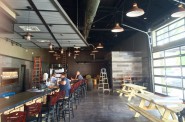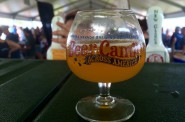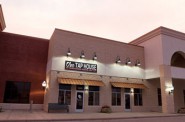The Rise of Sour Beers
The Belgian-styled beer is finding American fans, but craft brewers are slow to embrace the trend.
To many drinkers, a beer with the aroma of aged cheese and flavor of red wine vinegar is a spoiled brew. But in certain parts of Belgium, this is just another style of beer. And like many other European brews, Belgian sours have now crossed the ocean and are attracting American fans.
Once strictly found in the Flanders region of Belgium, the sour, or lambic, beer style is a bit of an oddball. It lacks the bitterness and inviting aroma of other styles and instead features a somewhat foul aroma and a prominently sour flavor. This is all made possible by purposely brewing with wild yeast culture and aged dry hops and allowing for naturally occurring microorganisms to enter the beer during overnight cooling. The end product is what is known as Pure Lambic. While it can be consumed in this state, Pure Lambic is often the base for six official variations to the style: Fruit, Mars, Gueze, Faro, Kriek, and Flanders Red Ale. (Mars is simply a lambic made using the second runnings of the mash used in the brewing of the Pure and has fallen into disuse in recent years.)
Each style has some unique characteristics. Gueze is by far the strangest in terms of brewing tradition, for it is a blend of Pure Lambic that has been aged two years and a fresh, partially fermented batch of Pure. Faro, too, is a blended beer, but this sub-style blends the lambic with caramel or molasses added post-brew. This gives the beer a sweet and sour flavor without increasing the alcohol content, for the caramel and molasses are not fermentable.
The final form of lambic is the Flanders Red Ale. Aged in oak barrels and made with select fruits and spices and a special red malt, which gives its namesake color, this beer is one of the rarer ones on the list and is found mainly in West Flanders. Like its cousins, it’s high in lactic acid and has very little hop bitterness to allow for the souring agents to thrive in the beer during fermentation. What sets this beer apart is that it is regarded as the strongest of the sours in terms of acidity and alcohol. Still, while coming in at 5-6 percent alcohol on average, it’s not the strongest beer on the market. However, when coupled with its acidity and bourbon spirit, this beer is pretty potent.
As mentioned previously, Lambics are a specialty style most commonly found in the Belgian region of Flanders. But like many other beer styles, the sour has travelled the world and caught the attention of Americans. Breweries such as Jolly Pumpkin, New Belgium, The Bruery, and Dogfish Head have successfully marketed their own versions of the sour which include brown and red ales, Berlin style Weiss, and even a stout. But what about Wisconsin? Surely the style has made its way to our state, if not Beer City itself.
As of this writing, of the many well-known Wisconsin breweries, only New Glarus and Sprecher have produced a sour and Sprecher’s Kriek Lambic is rarely available and may have been discontinued. While that may seem upsetting to sour fans, New Glarus more than makes up for the lack of competition in Wisconsin by offering four varieties of sour including Gueze, bourbon barrel kriek, and two kinds of Fruit lambic. However, these beers are restricted to specialty status, meaning they’re produced at irregular intervals due to the length of time it takes to produce a proper lambic, making them hard to find. Fortunately, a fifth sour, New Glarus’ Strawberry-Rhubarb lambic, made an appearance at a Milwaukee beer tasting.
So far, sour beers haven’t taken the country by storm. While there is certainly a dedicated and growing fan base for this style, what holds it back is the fact that these beers, like wine, have to be aged well over a year and sometimes up to three years. With such a long aging period many breweries are likely to find mass production not worth the effort. But out of pure interest in seeing an American take on the style and its many variations, I’m hoping the style catches on with more brewers. In the meantime, here’s a review of two sours: one from an established Wisconsin brewer and another poised to open up shop in Summer 2015. Cheers!
Battle Cry
Brewer: Northern Wolf Brewing – Milwaukee, WI
Style: American Black Sahti-Fruit Lambic Blend
ABV: 8.5%
Availability: Currently Unavailable
Thoughts: A blend of an Americanized Viking Age ale made with black, crystal, and dark rye malt and juniper berries and a fruit lambic made with raspberries. Black as night and heavy on the alcohol, this beer drinks thick and smooth with a complex flavor that’s smoky and bready with a moderate tartness from the raspberries. The berries themselves are a mixed bag however, for while the raspberries are prominent from start to finish, the junipers are hardly noticeable.
Brewer: New Glarus Brewing Co. – New Glarus, WI
Style: Fruit Lambic
ABV: 4%
Availability: Irregular
Thoughts: Quite possibly one of the most addictive beers I’ve ever had. Sweet and sour, smooth with a crisp bite and champagne-like body, this beer is stunning. At a recent beer tasting I had to have a second and third sample, knowing it was hard to find. As for the fruitiness, the strawberry is the front runner in the flavor department. The rhubarb is hardly noticeable making for a beer that tastes delightfully similar to a strawberry wine, but with an extra touch of citric acid.
Beer City
-
The Crowd Rules At MobCraft Brewery
 Jul 7th, 2016 by Joey Grihalva
Jul 7th, 2016 by Joey Grihalva
-
Sierra Nevada Beer Camp Was a Winner
 Jun 13th, 2016 by Joey Grihalva
Jun 13th, 2016 by Joey Grihalva
-
The Rise of O’so Brewing Co.
 Dec 1st, 2015 by Christophor Rick
Dec 1st, 2015 by Christophor Rick


















